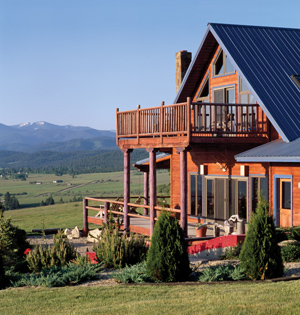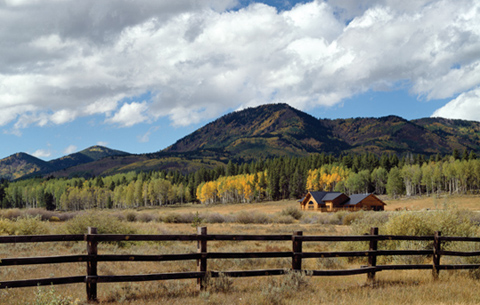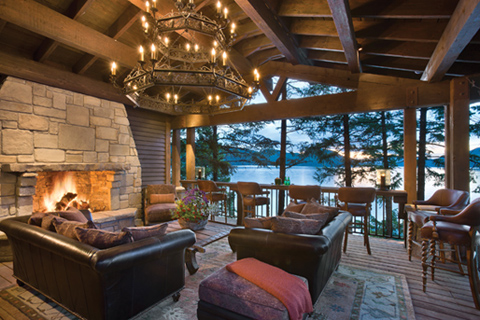Towering timbers, serene lake views, sweeping mountain vistas—log homes are a natural extension of the outdoors, and for many log home owners, the setting is as essential to their dream home as the structure itself. With such natural riches, it makes sense to invite the outdoors in by maximizing the views with your home design. The views should be considered right from the very first planning stages, and they will come into play with many decisions along the way.
Start with Your Site
The first time potential views come into consideration is when you are deciding where to place your home on your lot. Examine different ways of angling your home. If you have a picturesque view in just one direction (toward a lake or riverfront, for instance) you’ll want to make sure that side of the house has as many rooms as possible situated to take advantage of the view. If you have views in all directions, think about which room you’d like to face in the direction of sunrise, and which would be best for sunset.
“We think about how the house sits on the lot, the exposure, and how we want those particular rooms to enjoy the view,” says Nate Hilt, design coordinator at Tomahawk Log & Country Homes. Do you want to be able to gaze at the mountains while you’re washing dishes? Do you want the dining room to look out over the river? Or do you want an expansive property view from the great room that lends itself to daydreaming? “We can do a lot of different things to maintain our designs but still take advantage of the views,” says Hilt. “Site analysis is the first phase.”
Decks and Porches
It can be tempting to think of adding decks as the best way to maximize a view, but the railings can be more of a visual hindrance than you might realize. Often when you’re sitting down, the railing is right at eye level so you might find yourself gazing out at the handiwork of the railing instead of the sun setting over the lake.
 PrecisionCraft Log & Timber Homes/photo by Heidi Long
PrecisionCraft Log & Timber Homes/photo by Heidi Long
There are different ways to deal with deck railings, depending on your home design and preferences. “Code sometimes drives a little bit of what we can do,” says Hilt. “If we’re more than 24 inches above grade we have to use guard rails, but glass panels and cable railings allow us to preserve the views.” Another option to consider is removable or retractable screens on enclosed porches, so you can keep the screen from interfering with the view during those months of the year when you don’t necessarily need protection from bugs.
Windows
Whether you’re talking about floor-to-ceiling panoramas or a glimpse from the kitchen, your window choices will make a big difference in what you see —and what you don’t. Jay Parmeter, president and co-owner of Golden Eagle Log Homes, has built many of his own homes, so he knows how window selection and placement can impact views from day to day, and how your window choices will be determined in part by your property. “If you’re up on a hill looking down on a lake or valley, you have to be able to see down, so you’ll want to run the windows closer to the floor,” says Parmeter. “If you’re in a mountain valley you’ll want to see out, so you’ll want windows up high.”
Parmeter suggests homeowners envision being inside each room and plan ahead for what they’ll want to be able to see, especially for a prow room. “You gain a more panoramic view in a prow room,” he says. It’s also possible to slightly flex the glass in a prow room for an even broader view. Parmeter cautions homeowners not to forget the walkout basement (if they have one), and suggests putting windows with screens on the sides of rooms rather than in the middle of the view, to leave the main windows screen-free.
And while there’s something romantic about double-hung windows, the sash will definitely impede a view. “In a lot of areas where the view is important we stay away from double-hung windows so there is no mulling in your sight lines,” says Hilt.
 Photo by Scott Amundson
Photo by Scott AmundsonFor an eagle’s eye view of your landscape, consider adding a second story. Even just adding a loft with an expansive window or a rooftop lookout can give you a panoramic view of your property that is completely different from the scene at ground level. Upper-level lofts and decks are often great spots for stargazing because you don’t have the roofline obstructing the views. “The biggest surprise I ever had was a nighttime view,” says Parmeter. “We always think about the daytime views, but I had a cottage where I didn’t even realize how great the view was until we turned off the lights at night. The stars were spectacular!”
 Photo by Roger Wade
Photo by Roger Wade
Focal Points
If you truly want to take advantage of the view from your home, try to keep other visual distractions to a minimum. “I run into a lot of customers who want the fireplace to be a focal point on the view wall, but it will often take up a third of the wall,” says Parmeter. Not only do you then lose that space for windows, but the fireplace and the view end up in competition. In that case, Parmeter often recommends putting the fireplace to the side to preserve the views.
Furniture positioning (including outdoor furniture) is another thing to keep in mind. If you design your home to take advantage of the view, and then put deck furniture and umbrellas in the middle of your sight lines, you’ll defeat the purpose. Try clustering deck and patio furniture to the sides of your outdoor spaces, so they’ll be out of the way of views from inside the house.
Whether you’re perched on a mountaintop, nestled in a river valley, or tucked into a lakeside lot, opening your home to the great outdoors can only enhance it. Identify the best views from your site, and work with your home designer to make the most of them. With the right design, a great view is like an ever-changing picture that you’ll never tire of.


 Locati Architects; Old World Cabinet Company/photo by
Locati Architects; Old World Cabinet Company/photo by